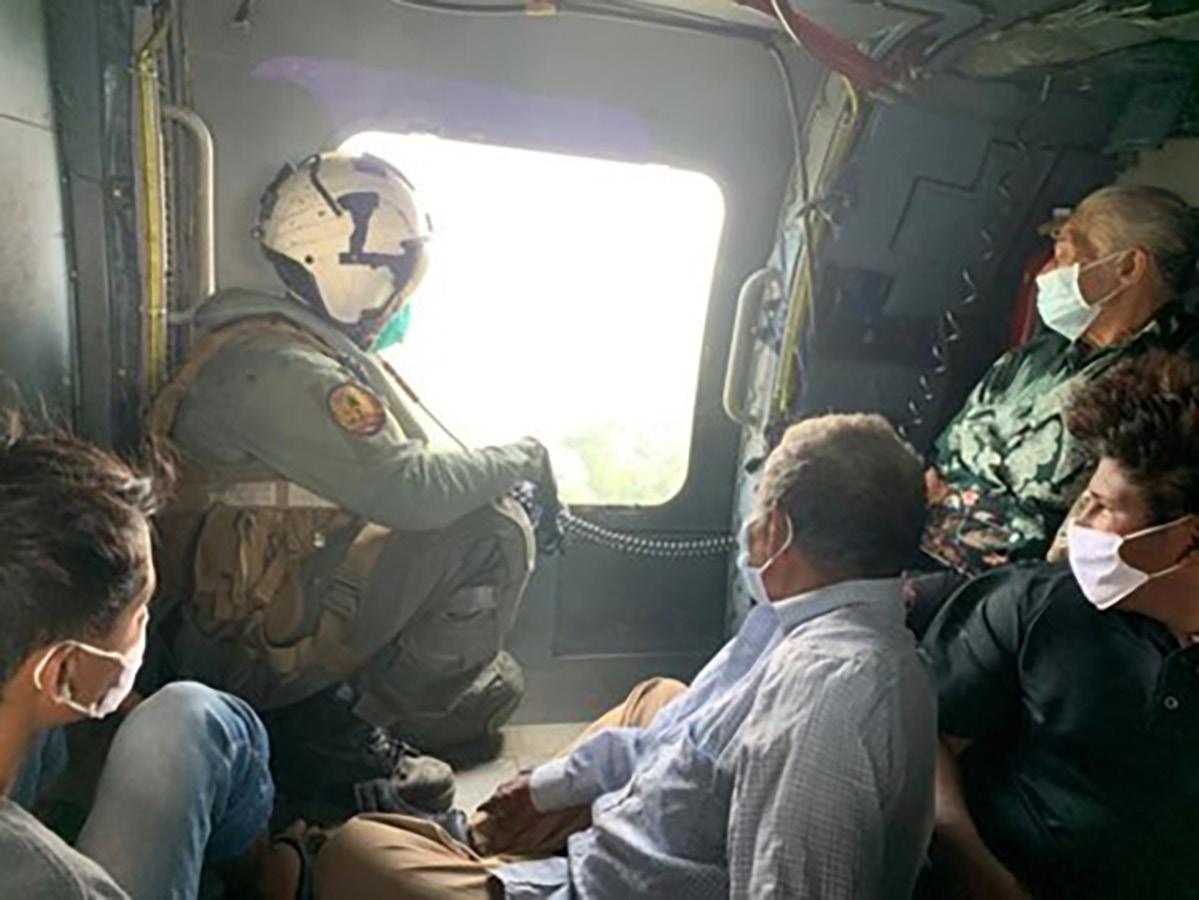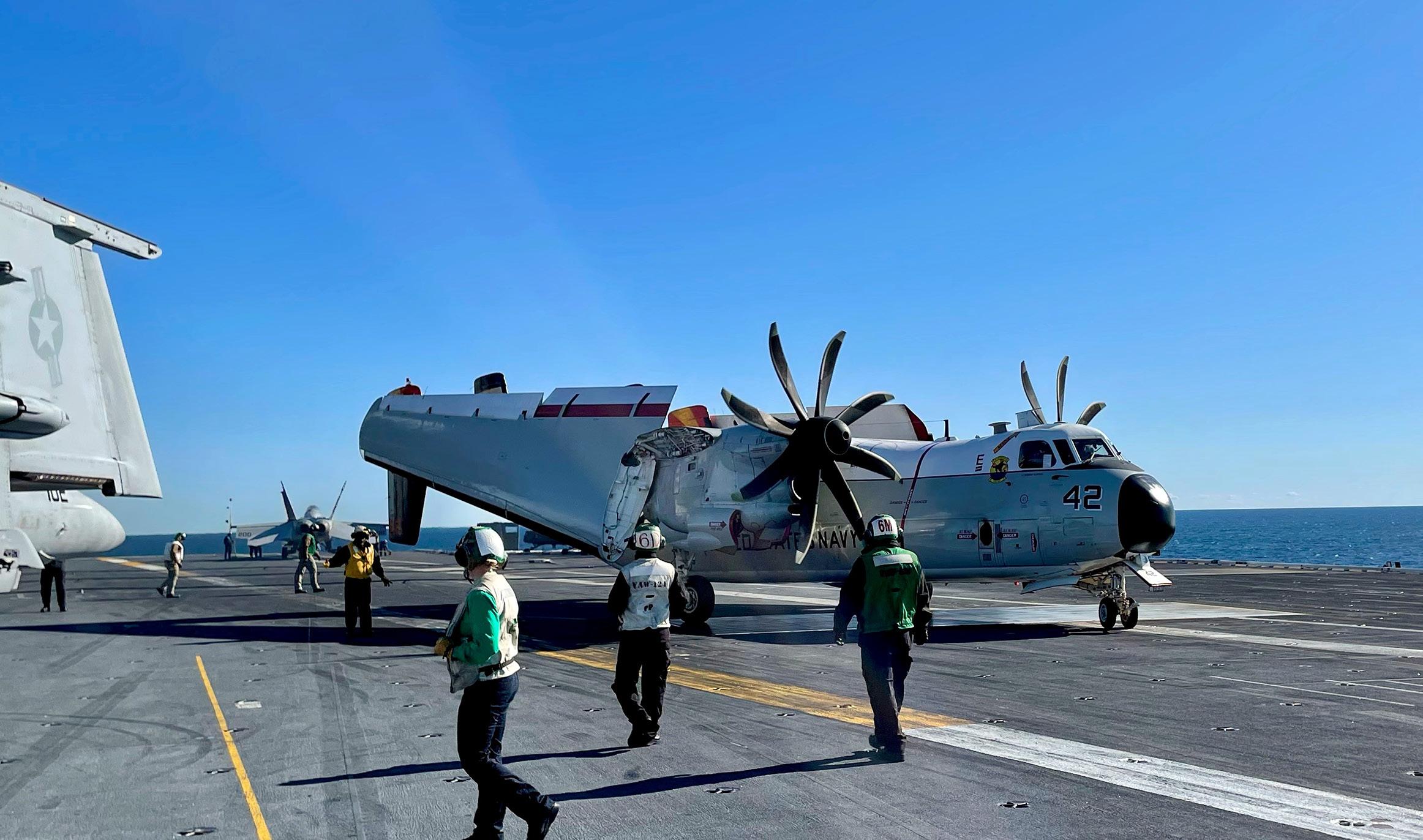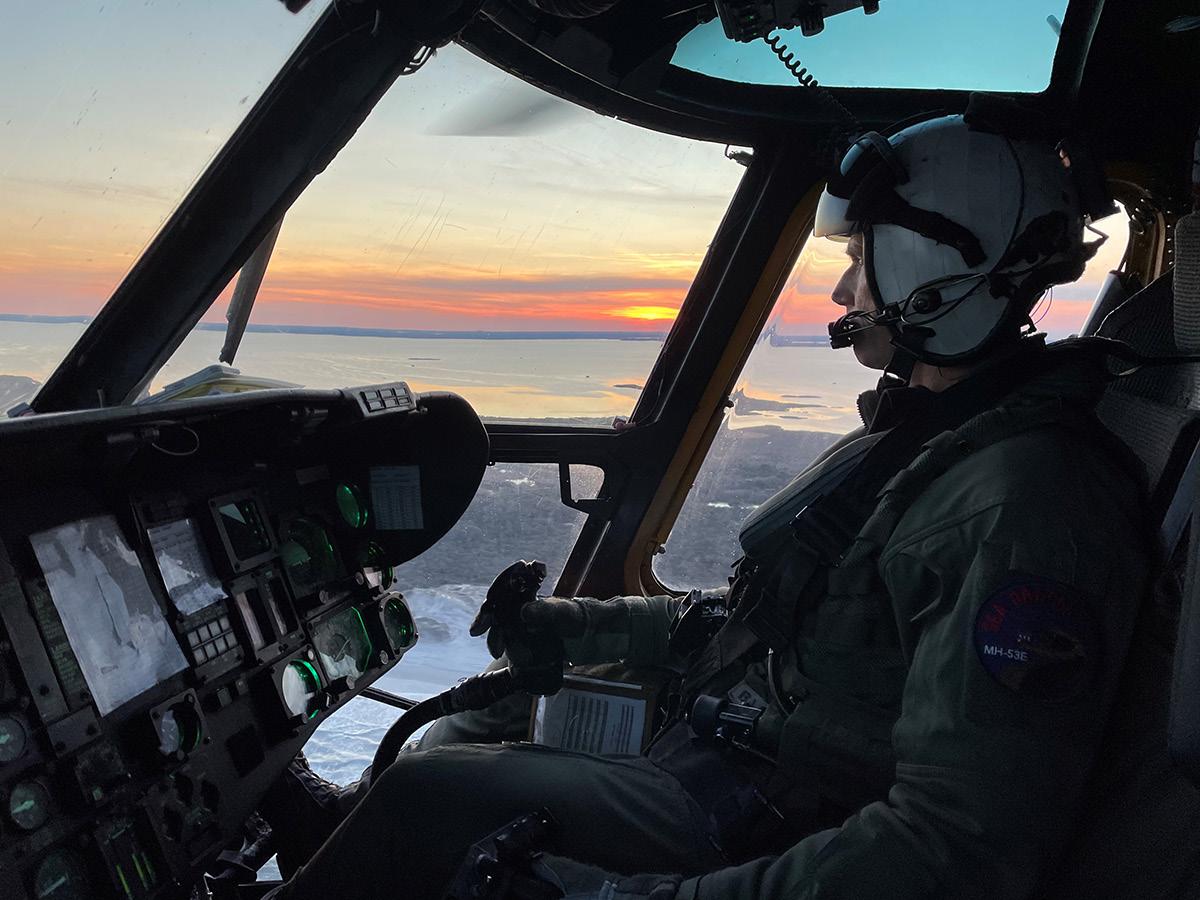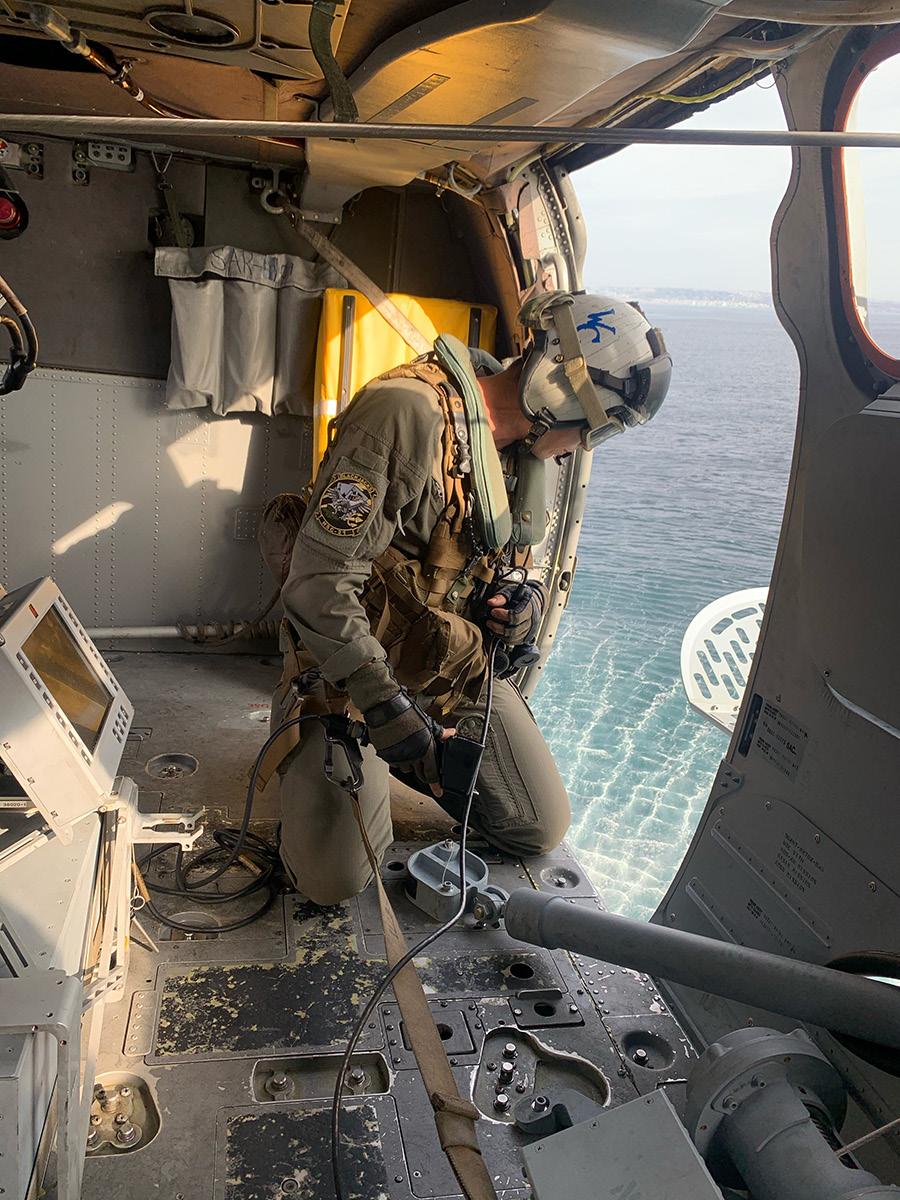
16 minute read
Easyrider 30, Urgent SAR Required!
By LCDR Adam “NOFORN” Rollins, USN
How an MH-60R crossed Central America to rescue 19 trapped Hondurans as a Category 5 Hurricane was hours from making landfall
As a new Officer-In-Charge (OIC) checking into HSM-37, I felt I had finally made it. For my entire career my family and I had wanted to be stationed in Hawaii, and I was lucky enough to be sent to the “Easyriders” of HSM-37 as a new Department Head. Within a few days of checking in, I learned that I would be taking Detachment 7 on deployment to the 4th Fleet AOR onboard USS William P. Lawrence (DDG 110) for a six-month counter-drug mission in the Caribbean Sea. With port calls every 10 days at a slew of exotic locales, this was going to be an epic deployment! WRONG. For this deployment, port calls were yet another casualty of the dreaded Coronavirus pandemic of 2020.
Although we were disappointed we would not be allowed to leave the ship, we were still motivated to deploy when we learned we would be embarking a United States Coast Guard Law Enforcement Detachment (LEDET) and Precision Marksman-Airborne (PM-A) for the counterdrug mission. However, in the back of my mind, I knew we would be in Central America through the fall, which meant hurricane season. While we trained for the Airborne Use-of-Force (AUF) mission off of Kauai, I mentioned to our aircrews that humanitarian aid/disaster relief (HA/DR) missions were a very real possibility on this deployment, and to pack accordingly. Little did I know how true this statement would become.
Fast forward three months and 740 kilos of cocaine later, our detachment was pierside at Naval Station Guantanamo Bay in a “Liberty Haven,” drinking warm beer and swatting mosquitoes. Our Detachment Maintenance Officer, LT Austin Stack, came up to me and said, “Ya know Boss, there’s a pretty big storm heading towards Central America. They say it’s supposed to dump a lot of rain. Do you think we will be tasked for HADR ops?” With all my wisdom as a supersalty OIC, I said “No way. The storm doesn’t look that bad, and besides, we’re heading to EASTPAC anyway for more AUF missions.” Again…WRONG!
Hurricane Eta hit the Yucatan Peninsula on Nov 3rd, 2020 with torrential rainfall, causing landslides and destroying critical infrastructure such as bridges and powerlines, and killing at least 178 people in Central America. Eta hit with such force that even after weakening in Central America, it had enough strength left to deposit manatees on people’s front yards in Florida (seriously…it happened!).
By this time, our ship had already transited south through the Panama Canal, and was under TACON to the Joint Interagency Task Force-South (JIATF-S) and USCG District 11. However, just as we cleared the canal, we were informed that we were proceeding north along Central America’s Pacific Coast, and were directed to prepare our aircraft for humanitarian assistance. While it was still unclear exactly where we were going, we had about 36 hours to ready our aircraft and conduct mission planning.
Finally, on Nov 11th, we were assigned a MODLOC on the EASTPAC side of Honduras, Nicaragua, and El Salvador in the vicinity of the Gulf of Fonseca. Joint Task Force-Bravo was requesting that our Detachment augment two U.S. Army UH-60L Blackhawks that were operating in the vast San Pedro Sula region of northwestern Honduras and flying around-theclock HADR and Search and Rescue missions.
After a quick look at the charts available on our ship, it became immediately clear that this was not going to be an ordinary HADR mission. Between us and San Pedro Sula stood not just one, but two major mountain ranges with peaks over 9,000 feet tall. To make matters worse, all we had for mission planning was a low-altitude enroute chart and a terrain relief map of Central America. Luckily, a few of us had Fore Flight on our tablets and smartphones, which proved to be invaluable in the coming days. We immediately started planning a low-level route that could take us through both ranges, which led us to our next obstacle: fuel availability.
Our route from EASTPAC to San Pedro Sula was roughly 380 miles round trip. Even with auxiliary fuel tanks, our time on-station would have been minimal. Just as we were considering options for fuel in Honduras, we learned of an Army unit at Soto Cano Air Base in Central Honduras. After only a few calls on the ship’s POTS line, the U.S. Army’s 612th Aviation Support Battalion was willing to set up a hot FARP for us at the halfway point, and another at a landing zone near the operating area called LZ Rivas. Now we were back in business.
On the first day of the operation, I flew with LT Austin Stack on a HAC/HAC flight as a proof-of-concept to see if it was even possible for us to operate out of EASTPAC, and to see if both FARPs would be available, compatible, and reliable for us. We launched off of the ship, and a little over 3 hours later landed at LZ Rivas—a CAL next to a Honduran Military Barracks—where we were able to take on hot fuel. While the route itself was straightforward enough, we identified a number of significant challenges.
Our ability to establish and maintain communications with any air traffic agency proved to be extremely difficult. We had to be up around 8,500 feet MSL to establish communications with the ADIZ controllers in order to enter Honduran airspace. There was a very real communication barrier, as most of these controllers as well as local approach controllers had no idea a U.S. Navy warship was right off of their coast launching its helicopters into their airspace, even though we had flight plans filed with APACS clearance. We had to constantly juggle the high-altitude requirements of maintaining communications with the performance and weather factors associated with operating at those altitudes. Furthermore, as we checked into San Pedro Sula, we were told by one of the Blackhawk pilots that they had just rescued the local air traffic controllers from the roof of the airport a few days prior to our arrival, so there were no ATC services in that portion of the country. On top of all this, our EGIs kept losing GPS signal as we entered the steep terrain of the valley.
The second challenge and the most obvious was the mountain weather. The ceilings, visibility, and winds through both mountain passes were highly unpredictable, with extremely limited forecasting available. We were able to check METARs and TAFs at Soto Cano Air Base, but we would have to rely on commercial online weather resources to fill in the gaps in our go/no-go decision making.
Lastly, our most significant challenge was aircraft performance. While crossing over portions of the mountain passes, our density altitude was regularly reading over 11,500’ on the NAV table. We were already feeling the familiar 4-per vibe of the onset of retreating blade stall at just 94 KIAS and bank angles of only five degrees. A contact at the 1-228 Aviation Regiment sent us a performance map of Honduras, indicating where it was possible to maintain single-engine cruise capability for a UH-60L weighing 22,000 pounds. Unfortunately for us, nowhere along our route was it possible to maintain level flight on one engine. We returned to the ship convinced that the actual HADR portion of our mission was going to be the easy part. It was the round-trip low-level route each way through Honduras that was going to be the real challenge. We knew we would need to bring our most professional flying to the table if we were going to assist anyone, or else we would be the ones needing assistance.
The second day of the operation went off without a hitch. LT Stack flew with LTJG Mike Franklin and AWR2 Bruce Estaya, and they were able to successfully navigate the mountain passes and deliver 8,800 pounds of relief aid to 17 unprepared CAL sites across northern Honduras. They returned to the ship exhausted after a long day of flying, but ecstatic that they were able to accomplish the mission.
On Nov 14th, we launched in Easyrider 30 with myself, LT Matthew Faber, AWR2 Sultan Sullins, and AWR2 Isaac Lynn as our ship steamed west at 27 knots to meet a Chilean supply ship for a Replenishment at Sea (RAS) 80 miles from our planned takeoff location and 130nm from the Honduran coastline. We launched at 0820L and transited through the mountains to LZ Rivas, landing just before 1100L. With 2,000 pounds of fuel in the tanks, I requested 1,700 pounds of aid on the common radio frequency as we touched down in the LZ. “Easyrider 30, Urgent SAR is required” was the response from the LZ Operations Officer. He notified us that all aid drops were being suspended, and that all aircraft were being re-tasked for SAR. There were an estimated 90 people stranded on a dirt levee in the Choloma region of San Pedro Sula and our aircraft, along with two UH-60L’s from the Talons of the 1-228 and Witch Doctors of the 2-228 Aviation Regiments, were tasked with their rescue. Before departing, the OpsO warned us that the FARP was collapsing at 1400L to evacuate since Hurricane Iota was less than 24 hours from making landfall, but that they would hold the hot pump team for us until we checked out with them.
We were passed the MGRS location of the levee system and departed the LZ after both UH-60Ls were clear. As we closed the search location, Witch Doctor and Talon departed to the north to begin SAR operations on the northern section of the levee system. We proceeded at best speed to the MGRS grid while rigging the cabin for rescue. We descended to 200 feet AGL, and while passing directly overhead, saw no sign of any survivors or life. LT Faber and I actually requested confirmation for the grid location from Witch Doctor, since there seemed to be no survivors in sight. Suddenly, looking down through the canopy of palm fronds, we saw a person running through water towards the levee. As we circled the MGRS point, more and more people began to flood onto the top of the levee and began frantically waving at us.
Only after getting eyes on-scene could we really assess what we were dealing with on the ground. The portion of the levee that we were flying over was made of dirt piled about 30 feet high and about a mile long. Across the top of the levee was a dirt clearing that was being used as a road, about 8 feet across. The levee was oriented north/ south, with a steep drop off on the west side and flood water on the east side approximately 10 feet from the top of the levee’s crest. About a quarter of a mile south of our location, the levee was already compromised, with floodwater draining into a swelling river system. Three quarters of a mile north of our MGRS grid, the road atop the levee was submerged by floodwater as well, preventing the Hondurans from self-evacuating.
We circled the area three times and discussed our options for rescue. It was possible to lower the basket and an aircrewman, but with the number of people needing rescue, the fuel it would consume to stay in a HOGE would be too high. As we continued to circle, the survivors on the levee moved to a dirt road that intersected the top of the levee. This left a space about as wide as our main mounts and a clearing where we could land the aircraft. After completing our SWEEP checks, we determined a 180 degree pedal turn was necessary over the landing sight, or else all of the survivors would have to walk underneath the tail rotor to get into the cabin. We made our approach and set the aircraft down on top of the levee, and AWR2 Sullins and AWR2 Lynn reported the ground was holding. Immediately, our AW’s sprang into action and ran towards the survivors to begin loading the aircraft.
First into the aircraft was a family of five, who were only carrying a single plastic grocery bag each of personal belongings. As soon as they were in the cabin they began asking for water, since up to this point they had not received any aid. The next group of survivors was about 200 yards from our location, so we decided to lift and depart since we would be back in only minutes. We pulled max power and were making 150 knots across the ground as we sped towards Choloma Futbol Stadium, which was acting as the drop off point for all survivors. We landed in the stadium and were immediately met by Honduran Police, first responders, and local city officials. There was also a significant media presence, and the local politicians were definitely using this opportunity to stage photos. As we prepared to leave, local police began loading 45kg bags of food and bottled water into the aircraft and told us to deliver them to the remaining groups of people on the levee system.
We departed the stadium and flew directly back to our original landing site. By this time the next group of survivors was lined up and ready to go. We landed again on top of the levee, with the aircraft in a hard left lean about 7-8 degrees left wing down. I elected to keep partial power on the aircraft to prevent further settling or sliding off of the levee. AWR2 Sullins and AWR2 Lynn both jumped out again, and carried the water and aid to a nearby dropoff point. The next group into the aircraft was an elderly couple and a young family of three. Once they were in the aircraft, fear, relief, or uncertainty of what was about to happen overcame them and tears were shed by all. We departed the levee a second time, and within four minutes were back on approach to Choloma Stadium. After repeating the process of survivors getting out, politicians taking pictures, and loading up with aid, we departed again to return to the levee. On our third and final approach to the levee, two families were prepared to evacuate.
Emotions were running high for the survivors as the wives, children, and grandparents tearfully said goodbye to their husbands, fathers, and brothers atop the levee. We decided to take as many as we could on the last load, and loaded nine survivors in the cabin. We thought we had room for at least three more survivors, but the remaining male survivors on the levee refused to leave. AWR2 Sullins tried to reason with them, and told them they needed to leave now because we were not coming back due to our fuel state. They said they were going to try to hike out tomorrow now that the women, children, and elderly were safely evacuated. Our AWs returned to the aircraft, where they kicked out the last of any food and water before closing the cabin door. We left the levee for the last time, and within minutes were safe on deck at Choloma.
After leaving Choloma Stadium, we proceeded to LZ Rivas for a final hot pump before returning home since we had about 300 pounds of fuel until our bingo. As we touched down at the LZ, the Air Operations Officer ran out to us with the final mission of the day. An elderly woman needed a MEDEVAC, and he was asking if we had the fuel to support. We knew we could, but looking to the south the developing thunderheads over the mountains gave us pause. We plotted the coordinates of the pickup points and realized we could make the trip in about 12 minutes from takeoff to landing. We gave him the thumbs us, pulled power, and flew at max speed to an LZ near the MEDEVAC. Again, our AWs exited the aircraft and carefully placed the elderly woman in the cabin. We departed, and a few minutes later landed at the field hospital next to LZ Rivas for patient drop off as well as one more hot pump. We topped off our tanks at 4,500 pounds, and pulled every percent of torque we could get out of Easyrider 30 to clear the 100 foot tall trees surrounding the LZ.

Easyrider 30 in Choloma Futbol Stadium after dropping off survivors.
We immediately turned towards the mountain valley we used to enter San Pedro Sula and climbed to 8,000 feet MSL. Within minutes it was clear that we were not going to be able to leave the way we came. Towering dark cumulus clouds lined the valley, with visibility less than 2-3 miles and rain. At the last minute, we diverted east towards a mountain pass with less aggressive looking weather. However, at this point we were off our route and had to revert to tried and true low-level navigation using pilotage, dead reckoning, and a tactical pilotage chart (TPC). If you were to tell me that the MH-60R’s advanced EGI’s would be useless I would have said you’re crazy. But here we were, without GPS, crossing deeper into central Honduras on an unknown and uncharted route. To say every crew member was giving one-hundred percent of their focus and energy was an understatement. Eventually we were able to cross under the weather, climb up to reestablish our GPS position, and establish communications with Soto Cano Approach.
At this point, we had no idea where our ship was; we just knew we had a location and a time where our Captain assured us they would be. We had planned numerous bingos after leaving LZ Rivas: back to Rivas, back to Soto Cano, to our ship, and to an emergency fuel divert at a field called CSL Comalapa in El Salvador. However, not knowing our ship’s exact position for fuel planning was extremely unnerving. In what seemed like divine intervention, just as we were discussing turning back to Soto Cano, a U.S. Navy P-8— callsign OMN—overflew us in the valley. They were able to relay our ship’s position via Link 16, and while we were relieved to know their location, we were shocked to find they were still over 200 miles away from our current position! Of course, as Murphy’s Law attests, whatever can go wrong will go wrong, and the RAS had been delayed nearly two hours. To complicate matters they had also been on a southwesterly PIM, heading away from our operating area. We immediately recalculated our fuel numbers, and determined that we still had enough fuel to continue to the ship. However, not all was lost. USS William P. Lawrence was now closing us at over 30 knots, and as soon as we went feet wet near the Honduran/ Nicaraguan border, we were able to establish Hawklink and confirm that they were ready to recover us. We transited the remaining distance and landed uneventfully onboard at 1530L.
To say we were relieved to be back on deck was another understatement. The total round-trip mileage flown from our ship to the rescue location and back was nearly 750nm miles throughout the course of 7.2 hours in the air; the majority of which was through high-altitude mountainous terrain with no single-engine cruise capability and significantly degraded communication and navigation coverage. It was only through detailed pre-mission planning, constant time-critical ORM assessments, mission adaptability, and a highly-focused crew of Aviators and Aircrewman were we able to pull off this successful rescue. Additionally, the professionalism and generosity of the men and women of Joint Task Force Bravo, as well as the 1-228 and 2-228 Aviation Regiments were incredible. They seamlessly integrated us into their operation, and were highly cognizant of our fuel requirements (all Blackhawks gave us fuel priority at the FARPs whenever we needed it). I could not have been more proud of our Detachment, our crew, and our aircraft for stepping up to the challenge and I know 19 Hondurans who will be forever grateful.

AWR2 Sullins clears the right side of Easyrider 30 as it lifts off from atop a levee with survivors onboard.










